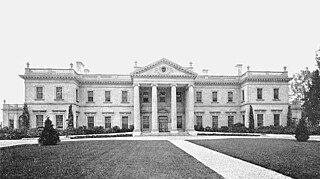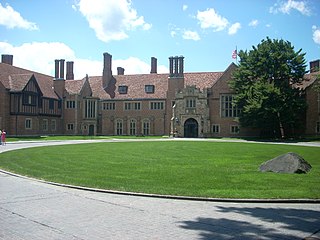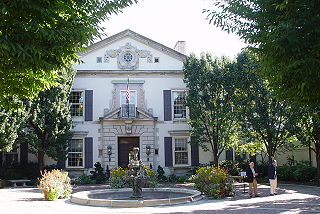
Grosse Pointe is a city in Wayne County in the U.S. state of Michigan. As of the 2010 census, the city had a population of 5,421.

Grosse Pointe Farms is a city in Wayne County in the U.S. state of Michigan. The population was 9,479 at the 2010 census.

Grosse Pointe refers to an affluent coastal area next to Detroit, Michigan, United States, that comprises five adjacent individual cities. From southwest to northeast, they are:

Whitemarsh Hall was a large estate located on 300 acres (1.2 km2) of land in Wyndmoor, Pennsylvania, United States, and owned by banking executive Edward T. Stotesbury and his wife, Eva. Designed by the Gilded Age architect Horace Trumbauer, it was built in 1921 and demolished in 1980. Before its destruction, the mansion was the third largest private residence in the United States. Today, it is regarded as one of the great losses in American architectural history.

The Elms is a large mansion located at 367 Bellevue Avenue, Newport, Rhode Island, completed in 1901. The architect Horace Trumbauer (1868–1938) designed it for the coal baron Edward Julius Berwind (1848–1936), taking inspiration from the 18th century Château d'Asnières in Asnières-sur-Seine, France. C. H. Miller and E. W. Bowditch, working closely with Trumbauer, designed the gardens and landscape. The Preservation Society of Newport County purchased The Elms in 1962, and opened the house to the public. The Elms was added to the National Register of Historic Places in 1971, and designated a National Historic Landmark in 1996.

Horace Elgin Dodge Sr. was an American automobile manufacturing pioneer and co-founder of Dodge Brothers Company.

Horace Trumbauer was a prominent American architect of the Gilded Age, known for designing residential manors for the wealthy. Later in his career he also designed hotels, office buildings, and much of the campus of Duke University.

Meadow Brook Hall is a Tudor revival style mansion located at 350 Estate Drive in Rochester Hills, Michigan. It was built between 1926 and 1929 by the heiress to the Dodge automaker fortune, Matilda Dodge Wilson and her second husband, lumber baron, Alfred Wilson. Covering 88,000 square feet (8,200 m2) with 110 rooms, the structure is the fourth largest historic mansion museum in the United States, and is classified as one of America's Castles. In 1957, the mansion and the surrounding property and buildings were donated to the state of Michigan in order to fund Michigan State University–Oakland, now known as Oakland University. The structure was named a National Historic Landmark in 2012.

The architecture of metropolitan Detroit continues to attract the attention of architects and preservationists alike. With one of the world's recognizable skylines, Detroit's waterfront panorama shows a variety of architectural styles. The post-modern neogothic spires of One Detroit Center refer to designs of the city's historic Art Deco skyscrapers. Together with the Renaissance Center, they form the city's distinctive skyline.

TheWar Memorial, also known as the Russell A. Alger Jr. House and as the Moorings was dedicated to the memory of veterans and soldiers of World War II. It is located at 32 Lake Shore Drive in Grosse Pointe Farms, Michigan.

The Edsel and Eleanor Ford House is a mansion located at 1100 Lake Shore Drive in Grosse Pointe Shores, northeast of Detroit, Michigan; it stands on the site known as "Gaukler Point", on the shore of Lake St. Clair. The house became the new residence of the Edsel and Eleanor Ford family in 1928. Edsel Ford was the son of Henry Ford and an executive at Ford Motor Company. The estate's buildings were designed by architect Albert Kahn, its site plan and gardens by renowned landscape designer Jens Jensen. The property was listed on the National Register of Historic Places in 1979, and was designated a National Historic Landmark in 2016.

The Elkins Estate is an American 42-acre (170,000 m2) estate located in Elkins Park, Montgomery County, Pennsylvania. The estate contains seven buildings, the most notable being Elstowe Manor and Chelten House, mansions designed by Horace Trumbauer. A wedding venue and spa is scheduled to open in Elstowe Manor in Spring of 2023.

The James B. Duke House is a mansion at 1 East 78th Street, on the northeast corner of Fifth Avenue, on the Upper East Side of Manhattan in New York City. The building was designed by Horace Trumbauer, who drew heavily upon the design of Château Labottière in Bordeaux. Constructed between 1909 and 1912 as a private residence for businessman James Buchanan Duke and his family, the building has housed the New York University (NYU)'s Institute of Fine Arts since 1959.

Anna Thompson Dodge was a Scottish-American socialite and philanthropist, one of the richest women in the world at the time of her death.

Miramar is a 30,000-square-foot (2,800 m2) French neoclassical-style mansion on 7.8 acres (32,000 m2) bordering Bellevue Avenue on Aquidneck Island at Newport, Rhode Island. Overlooking Rhode Island Sound, it was intended as a summer home for the George D. Widener family of Philadelphia.

The Carl E. and Alice Candler Schmidt House is a private home located at 301 Lake Shore Rd. in Grosse Pointe Farms, Michigan. It was listed on the National Register of Historic Places in 2005. Built in 1904, the house is one of the oldest remaining properties in the Grosse Pointes to have a view of Lake Saint Clair.

Hugh Tallman Keyes was a noted early to mid-20th-century American architect.
The W. Hawkins Ferry House, or William Hawkins Ferry House, is a private house located at 874 Lake Shore Road in Grosse Pointe Shores, Michigan. It was listed on the National Register of Historic Places in 2019.
Duncan Willson Candler was an American architect known for his various projects for Abby and John D. Rockefeller Jr. and the house Skylands for Edsel Ford. Martha Stewart says Candler is "a genius who deserves a book."
The Grace Ingersoll McGraw House is a private residence located at 17315 East Jefferson Avenue in Grosse Pointe, Michigan. It was listed on the National Register of Historic Places in 2023.























